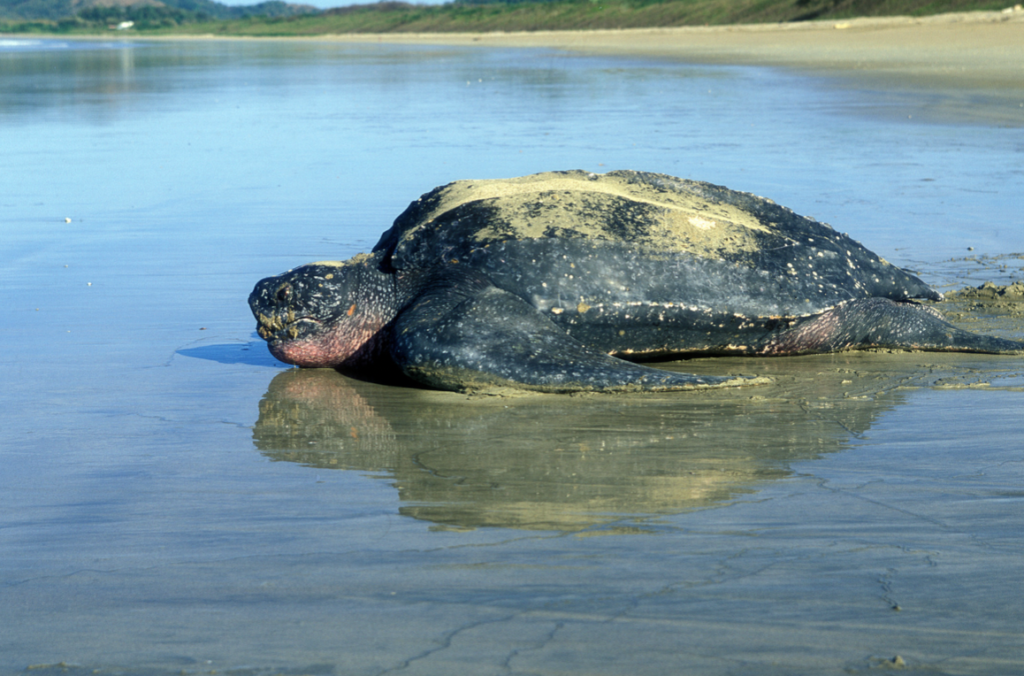Species in Peril:
LEATHERBACK TURTLES
Long-distance swimmers
Large and strong
The leatherback sea turtle is the largest turtle on the planet. They are the only species of sea turtle that lacks scales and a hard shell. They’ve existed in this form since the time of the dinosaurs, and they’re noted for their thick, rubbery skin. Leatherback turtles are migratory, traveling almost 10,000 kilometers each year between nesting and feeding grounds. They are also skilled divers, with the deepest dive ever recorded reaching over 4,000 feet, which is significantly higher than that of other marine mammals.
They're everywhere and nowhere!
The Atlantic, Pacific, and Indian Oceans are all home to leatherback turtles. The majority of nesting beaches are found in tropical latitudes around the world. The world’s largest remaining nesting aggregations are in Trinidad and Tobago (Caribbean) and Gabon (Africa).
Leatherback turtles can be found in the Northwest Atlantic, West Pacific, and East Pacific off the coast of the United States. Leatherback turtles from the western Pacific feed off the coast of North America before migrating across the Pacific to lay their eggs in Indonesia, Papua New Guinea, and the Solomon Islands. Eastern Pacific leatherbacks, on the other hand, lay their eggs along the Pacific coasts of Mexico and Costa Rica and forage in the tropical Pacific Ocean’s south-central and eastern regions.
They need our help!
Under the Endangered Species Act, the leatherback sea turtle is considered endangered. Over the last three generations, the global population is thought to have decreased by 40%.
Leatherback nesting in Malaysia has practically vanished, with about one or two nests per year since 2003, down from around 10,000 nests in 1953.
As shown by continuous losses in nesting across their range, Pacific leatherback turtle populations are most at risk of extinction. The Eastern Pacific leatherback turtle population’s primary breeding areas are Mexico and Costa Rica, with some isolated nesting in Panama and Nicaragua.
Nesting in this area has decreased by almost 90% in the last three generations.In the Western Pacific, the largest remaining nesting population, which accounts for 75 percent of the Western Pacific population, occurs in Papua Barat, Indonesia and has also declined by over 80 percent. This is largely due to constant threats of entanglement in commercial fishing gear, poaching of turtles and turtle eggs from nesting beaches, and ingestion of plastics and pollutants that make their way into the ocean.
A Few More Facts About these turtles
|
Video: Baby leatherback turtles heading out to sea
Leatherbacks are in danger
The leatherback turtle is in grave danger and their numbers are decreasing fast. You can help by reducing your utilization of single-use plastics (straws, plastic bags). Don’t leave trash on beaches. Use a sunscreen that is ‘reef friendly’. Keep at least 20 ft from a resting turtle. Donate to an organization such as Sea Turtle, Inc (www.seaturtleinc.org). And never leave fishing lines or hooks behind.

Species Name
Dermochelys coriacea |
Estimated Population
25,000 and decreasing fast
Conservation Status
Endangered
Range
Atlantic, Pacific and Indian Ocean
Reasons for Population Decline
Entanglement in commercial fishing gear
poaching of turtles and turtle eggs
Ingestion of plastics and pollutants


